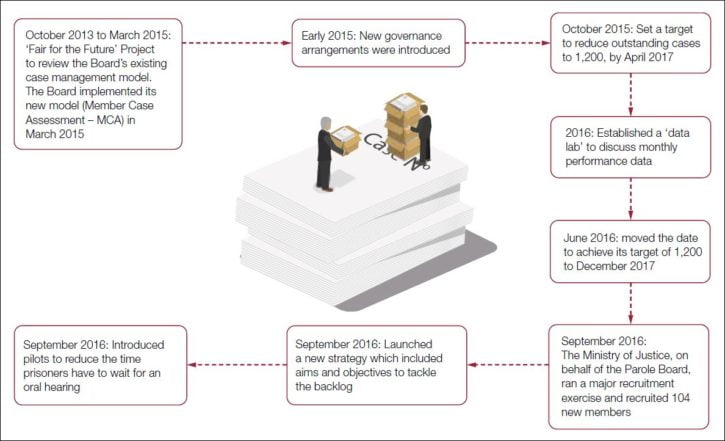Last week (28 February 2017) the National Audit Office published its report on an investigation into the backlog of outstanding cases at the parole board.
The parole board has been in a mess for some time and last year (January 2016) Nick Hardwick, previously a much respected Chief Inspector of Prisons, was appointed its chair to try to unravel it. The graphic below from the NAO shows the extent of the backlog:

What is the parole board?
The parole board is an independent body which risk assesses prisoners to decide whether they can safely be released into the community. 115 staff plan and co-ordinate the activities of 215 independent parole board members. The decisions they make are obviously critical both to prisoners and their families and to victims and their families. Making safe parole decisions equally obviously has a significant impact on the numbers in prison.
Why is there such a backlog?
The parole board has had a backlog for many years but the situation was aggravated when the Board had to increase the number of oral hearings it must carry out following the Supreme Court’s Osborn, Booth and Reilly judgment in October 2013 (the Osborn ruling). This ruling followed appeals to the Court from three prisoners, each of whom had been refused oral hearings. It broadened the circumstances in which the law requires the Board to hold an oral hearing, with fairness to the prisoner being the overriding factor. The Board can no longer refuse to carry out an oral hearing because it considers that the hearing is unlikely to make a difference or in order to save time, trouble or expense. The number of outstanding cases increased by more than 140% following the Osborn ruling.
Another graphic from the NAO report shows the impact of the backlog:

In addition to the heartache and stress caused to prisoners spending longer in custody than they should, the parole board has paid out over £1 million since 2011 in compensation claims as a result of delayed hearings.
Tackling the backlog
As you can see from yet another graphic below (the NAO is rather good at them), the parole board has been working hard to try to tackle the backlog by introducing new governance and performance management arrangements as well as recruiting 104 new members:

IPPS
 |
| END UNNECESSARY CAPTURE OF RECALL |
The situation is aggravated by the ongoing debacle of the IPP situation – prisoners on indeterminate sentences of imprisonment for public protection. Despite being abolished in 2012, 2t December 2016, there were 3,081 prisoners on IPP beyond their tariff expiry date. IPP prisoners can only be released if the Board considers that they are no longer a risk to the public, even if they have reached the end of their tariff. IPP prisoners have on average made up around half of the cases waiting more than 90 days for a hearing. Of the 3,683 IPP prisoners still in custody in December 2016, 84% (3,081) were beyond their tariff expiry date. Of these, 48% had been in prison five or more years beyond their tariff and 11% were eight years or more beyond their tariff.
In July 2016, the Board announced its intention to reduce the number of IPP prisoners in prison to 1,500 by 2020 which seems to me to be a rather pathetic target.
Worst figures on record
At the end of last month (27 April 2017) the Ministry of Justice and Office of National Statistics published the latest Safety in Custody Statistics Bulletin, covering deaths in prison custody up to March 2017 and assaults and self-harm to December 2016.
The key findings continue to be shocking, although there is a slight downward dip in the number of assaults in the last quarter:

Deaths
The number and rate of deaths for the most recent year (up to March 2017) are the second highest recorded. Deaths in the most recent quarter are down from the 12 months ending December 2016 but are still the fourth highest on record.


Self-harm
The number of self-harm incidents and those requiring hospital attendance are both the highest recorded. In the most recent quarter, from October to December 2016, self-harm levels were the highest on record, with 10,246 incidents of self-harm and 734 incidents requiring hospital attendance.


Assaults
The most recent quarter saw a decrease in all types of assaults compared to the three-month period from July to September 2016, when all types of assaults were at their highest levels on record. Total assaults fell by 4% across this period while prisoner-on-prisoner and assaults on staff fell by 5%. This is the first quarter that total assaults have decreased since October to December 2014, but should be considered with caution due to potential seasonal effects.
Conclusion
The speed at which prison safety has deteriorated is a cause for major concern with the annual numbers of deaths, suicides, incidents of self-harm and assaults all the highest on record.
It is this situation which led to parliament’s Joint Committee on Human Rights to call on the next government to introduce legislation setting a minimum ration of prison officers to prisoners in every establishment.
We shall to wait until after the election to see whether the new government acts on this recommendations
.............................................................................
LIZ TRUST
First thing first what about the IPP Prisoners Mental Health and sentence right NOW?
http://www.russellwebster.com/truss-prison-reform-speech/
No comments:
Post a Comment
comment
Note: only a member of this blog may post a comment.